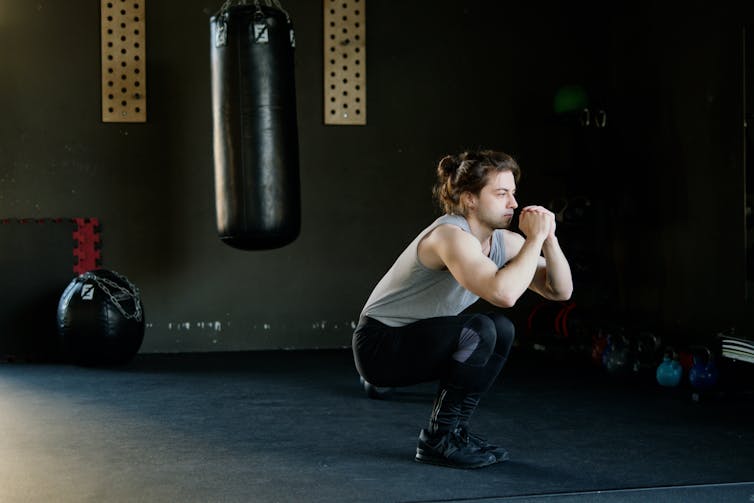This finals season, a brief ‘priming’ workout could boost performance on the sports field and beyond
- Written by Christopher Latella, Lecturer, Master of Exercise Science (Strength and Conditioning), Edith Cowan University

As humans, it is in our nature to want to do better, find that edge and succeed. This couldn’t be truer than in sport, where winning and losing are often separated by tenths of a second, a successful score attempt in the dying stages of a game, or a split-second decision.
So, there is always a need for effective and legal strategies to boost performance. “Priming” is a tool attracting more and more interest from athletes, coaches and scientists.
The good news is it is not just for elite athletes.
Not just a warm-up
Priming, also called “morning exercise”, “pre-activation” or “pre-competition training”, has attracted renewed interest among scientists in recent years. Many sporting teams are already on the ball, with more than half of coaches using priming to help their athletes gain a performance advantage.
Typically, a relatively brief and non-tiring bout of exercise is performed the day before or on the morning of a competition – somewhere between one and 48 hours beforehand. This stimulus to the muscles results in “delayed potentiation”. That is, the muscles can perform better after several hours of rest than they would have without the priming exercise.
In contrast, a warm-up takes place much closer to competition. What’s interesting is the benefits of priming are much longer-lasting than those typical of warm-up activation strategies. This is perplexing because we know that increases in muscle temperature, metabolism and the nervous system potentiation with warm-ups return to baseline levels within minutes.
Warm-ups remain important but priming sessions could provide an additional edge. Sports scientists have reported improvements in running, jumping, throwing and weightlifting ability by as much as 4%. This might not seem like a lot, but it’s crucial when the difference between winning and losing can be measured in fractions of a percentage point. The physiological mechanisms that cause the priming effect are not yet well understood, but neuromuscular and hormonal changes have been suggested.
And it may not be only muscles that benefit. Researchers have long known priming exercise can improve weightlifting performance in anxious athletes. More recent research reinforces the idea priming activities can help athletes’ psychological state and stress levels.
Finding time to play, train and prime
Very few of us are elite, full-time athletes. Finding time to train and compete, even at a community or sub-elite level, is hard – let alone making extra time for additional priming sessions. But priming exercises can be done with minimal equipment in minimal time.
Basic exercises such as squats and bench presses with relatively heavy weights (around 85% of your maximum capacity) for just a few repetitions are enough to boost performance later that day.
Don’t have a rack of weights lying around? That’s OK. Explosive body-weight activities such as a few short sprints or jumping still have the potential to boost athletic performance. Stronger people seem to respond better to priming, likely because they recover more quickly from exercise.
Ideally, pick an activity that uses the same muscle groups you will use during your sport, and do the priming exercise six to 33 hours before your event, as this seems to offer the most benefit and practicality. And remember, more is not better. You may be able to incorporate your priming session into your existing training regime.
I don’t play sport – what’s in it for me?
Priming doesn’t just apply to sport; it may help in the gym and with learning new skills.
A 2014 study showed bench-press and squat performance was greater in the afternoon if they were used as priming exercises that same morning.
And ten to 30 minutes of aerobic exercise may improve reaction time, memory and attention. Moderately intense cycling has been shown to help musicians learn the piano. However, these changes appear more immediate and short-lived than those that relate to athletic performance, taking effect and lasting minutes rather than hours.
Read more: Can't get your teen off the couch? High-intensity interval training might help
What we still don’t know
There are still questions to be addressed when it comes to priming.
Could priming be useful in sports like rugby, football and basketball? These sports require multiple high-intensity efforts, coupled with dynamic decision-making to score and beat an opponent.
More research is also needed to work out what’s happening in the body and what exercises should be done when for the most effective priming. As researchers, we’re exploring the effect of different priming routines on muscular strength and power, as well as repeat sprint performance and reaction time in strength athletes and football players.
In particular, weightlifting protocols that provide strong stimulation, but minimise fatigue, seem promising. We expect the findings will be useful for coaches and athletes who want to improve athletic performance.
Authors: Christopher Latella, Lecturer, Master of Exercise Science (Strength and Conditioning), Edith Cowan University





